It's Admissions Season!
Register for a tour or inquire to learn more about WSP’s transformative preschool-12th education.
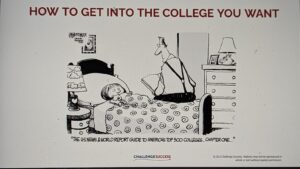
A little over a week ago, the U.S. News & World Report released their annual rankings of colleges and universities. Before long, I was receiving texts and emails from family, friends, and colleagues in higher education. This was nothing new; since I became a tour guide in my junior year at the University of North Carolina at Chapel Hill, prospective students and families would routinely ask me about the rankings. I would try to explain that regardless of rankings, there were so many reasons that I was enjoying my time at UNC: The breadth and depth of courses in my majors of political science and journalism, the plethora of restaurants on Franklin Street (the main thoroughfare right off campus where my friends and I often went for a late night bite of pizza or to celebrate a victory in basketball over our arch nemesis, Duke University), and the concerts I attended by a cappella groups named The Clef Hangers, The Loreleis, and Tar Heel Voices. I was happy at college, but in my young mind, rankings had nothing to do with it.
Yet the fervor – and sometimes furor – over these rankings persisted, especially once higher education became my calling. Working in the admissions offices of American University and Colorado State University, I continued to be asked about the rankings: by parents at college fairs, by students during admissions interviews, and by our local alumni who would speak at information sessions that I held in Philadelphia, Pittsburgh, Seattle, and Portland, among many other cities. I would also be not-so-slightly nudged by our Director of Admissions to highlight the U.S. News and World Reports ranking if the college or university had moved up. Or, alternatively, I was told to downplay the significance of the rankings should the university not fare as well as they had the previous year. As the years went by, I witnessed much change in higher education, but the obsession over college rankings remained constant.
Flash forward to the U.S. News and World Report rankings released earlier this month. Many colleges and universities lambasted these rankings because of changes to the U.S. News and World Report’s methodology. Wake Forest University, located in Winston-Salem, North Carolina, said that the U.S. News and World Report changed 17 of the 19 indicators used to calculate its rankings of institutions. Wake Forest University’s President, Susan R. Wente said, “Hallmarks of the Wake Forest experience include small classes, personal attention and mentoring from professors who are top scholars and experts in their fields. It is unfortunate that this year’s methodology no longer rewards institutions for some of the elements of the Wake Forest experience that we value most.” She continued, “Among other changes, the new ranking methodology removed consideration of small class size and teaching by professors with a terminal degree.”
That leads me to the refreshing and informative webinar that I attended last Wednesday, September 20th, by Challenge Success, a nonprofit affiliated with the Stanford University Graduate School of Education. Challenge Success partners with school communities to elevate student voice and implement research-based, equity-centered strategies that improve well-being, engagement, and belonging for all K-12 students. One of their founders, Denise Pope has been a longtime proponent of WSP. You can see her in our film Preparing for Life, and second film short here. Part of their presentation centered around how the college admissions process can be a source of stress and anxiety for students and parents alike. One of the questions they asked was, “What do college rankings really measure?”
Challenge Success has found out that rankings are problematic. In their article titled: A “Fit” Over Rankings: Why College Engagement Matters More Than Selectivity, they wrote:  “We find that many of the metrics used in these rankings are weighted arbitrarily and are not accurate indicators of a college’s quality or positive outcomes for students.” In last week’s webinar, Challenge Success included a comic strip in which a father is reading a bedtime story to his young child. The caption: “The U.S. News & World Report Guide to America’s Top 500 Colleges…Chapter One…” While humorous, I could not help but think that the illustration and words were not far from the truth.
“We find that many of the metrics used in these rankings are weighted arbitrarily and are not accurate indicators of a college’s quality or positive outcomes for students.” In last week’s webinar, Challenge Success included a comic strip in which a father is reading a bedtime story to his young child. The caption: “The U.S. News & World Report Guide to America’s Top 500 Colleges…Chapter One…” While humorous, I could not help but think that the illustration and words were not far from the truth.
And that brings me back to another key phrase by College Success: “Engagement in college is more important than where you attend.” Challenge Success says: “Colleges that provide ample opportunities for students to deeply engage in learning and campus community may offer the key to positive outcomes after college. For instance, students who participate in internships that allow them to apply what they learn in the classroom to real life settings, students who have mentors in college who encourage them to pursue personal goals, and students who engage in multi-semester projects” are, in fact, “more likely to thrive after college.” In fact, “the students who benefit the most from college are those who are most engaged in their academics and campus communities, taking advantage of the opportunities and resources their particular institution provides. Engagement is the key.”
Challenge Success emphasizes that students should focus on college readiness, rather than college rankings. At the webinar I attended last week, they had a slide that asked, “What does Readiness Look Like?” It included four areas: Academic Skills, Social Skills, Positive Coping Skills and Life Skills. Academic skills included: “Managing time, materials, and assignments; having good note taking skills, solid reading and writing skills; complex problem-solving skills; and communicating directly with teachers.” Social skills included: “Managing emotions and behaviors, showing understanding and empathy for others, managing conflict, and making ethical, constructive choices.” The better prepared for college, regardless of what the college is ranked, the better you will feel about yourself. In turn, hopefully, your stress level will decrease, and you can daydream about all the ways you will not only survive – but also thrive – in college!
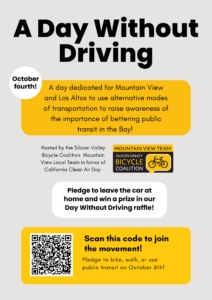
Hello, I’m a former WSP student and current Fordham University College Student. I am reaching out to share an event I’ve organized for the  Silicon Valley Bicycle Coalition – A Day Without Driving!
Silicon Valley Bicycle Coalition – A Day Without Driving!
A Day Without Driving will take place next Wednesday, October 4th, and is a day dedicated for people in Mountain View and Los Altos to use alternative modes of transportation throughout their day. All one has to do is register at this link and they’ll automatically be entered into a raffle. Feel free to download/share/print/post the flyer, at right.
I am encouraging parents, employees, and students at Waldorf School of the Peninsula to participate and sign up for A Day Without Driving. There are so many benefits to increasing alternative modes of transportation, and it’s my hope that this event will bring more awareness to its importance as well as provide a new lens to look at our community. After the event, a form will be sent out to participants to provide feedback of their experience and recommendations for specific areas of improvement which I will compile into a report and present to SVBC, stakeholders at the City of Mountain View, and our partners at VTA.
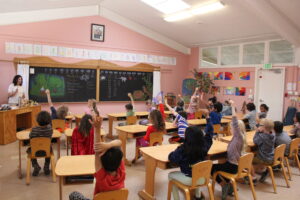
Years ago when I first taught elementary school, before I met Waldorf education, every year I would have a new group of students and I would spend the first few months getting to know them as they got to know me. As the months progressed, I would increase my understanding of how each child learned best. We would have a few months of solid learning and then, poof, it was summer, and the students would move on. In the fall, I would get another group of new students and we would start all over again. It was the same every year – just as you really got to know the students, the year was over. It was sad. Although switching to new teachers every year seemed normal to me then, in retrospect, there was a lot of time spent figuring out the best way to teach each child in your new class.
 One of many unique aspects of Waldorf education is that the class teacher traditionally stays with their class from grades one through eight. Parents sometimes ask why this is the tradition at Waldorf schools. Rudolf Steiner, the founder of Waldorf education, made this recommendation over a hundred years ago, stating that children benefit when they remain with their teacher, versus switching to a new teacher each year. Now, (as often happens with Waldorf’s unique practices), science has caught up with Steiner and recent research shows benefits, such as higher academic performance and improved school experience, for students who stay with the same class teacher (often called looping).
One of many unique aspects of Waldorf education is that the class teacher traditionally stays with their class from grades one through eight. Parents sometimes ask why this is the tradition at Waldorf schools. Rudolf Steiner, the founder of Waldorf education, made this recommendation over a hundred years ago, stating that children benefit when they remain with their teacher, versus switching to a new teacher each year. Now, (as often happens with Waldorf’s unique practices), science has caught up with Steiner and recent research shows benefits, such as higher academic performance and improved school experience, for students who stay with the same class teacher (often called looping).
One big benefit that research has shown with looping: when students return in the fall with the same teacher, the class doesn’t need to spend a lot of learning time getting to know each other. Successful learning can start right away because the teacher already knows how each student learns. And this ease with a familiar teacher creates a comfortable beginning for each returning student, too. Surprisingly, coming into a class where the teacher and students have been together longer positively impacts the learning of any new students as well.
We knew that if the teacher had more time with students, we could see some gains,” says Linda DeBerry, the principal at Dyersburg, which covers pre-kindergarten through second grade. Students in their second year with the same teacher typically learn over one-third more content than students in the same grade who had different teachers, DeBerry says. “We see evidence of this in all grades.” Principal DeBerry started looping teachers 15 years ago after noticing benefits when looping happened accidentally. “What we see is those teachers know exactly what student strengths and weaknesses are. At the beginning of the year, they don’t have to figure that out,” she says. “For students who don’t develop as fast, teachers have longer with them to reach goals.”
The reason, researchers conclude, is that longer relationships make both teaching and learning easier and improve student behavior. Looping with students, even if it doesn’t take place in sequential years, can be more efficient, says John Papay, associate professor of education and economics at Brown University’s Annenberg Institute. Papay, another lead researcher on the Tennessee study, cites the time teachers spend getting to know students at the beginning of the school year. “There’s an upfront cost – learning names, talking about goals, getting to know families,” he says. “If you have students a second year, you don’t have to do that. There’s less diagnostic work.”
Interestingly, Papay notes, the Tennessee study didn’t just find academic and behavioral benefits for students who had the same teacher for multiple years. There is a “spillover” effect during the second year of a looped classroom for students who are having the teacher for the first time. Students who are new to a teacher in a class where half of the students have had the teacher before also do better academically, have better attendance and fewer behavioral issues than they did in other teachers’ classrooms.” The Benefits of Teacher Looping – USNews by Kate Rix (February 2023).
Steiner discussed many benefits of the teacher and students staying together. One of them is that the teacher comes to know the student very well and can support their growth in the best way. The teacher can respond more readily to the students as they grow, with knowledge of where they were previously in their development and how they are progressing. The child feels the teacher’s care and attention. This warmth between the teacher and the child creates the perfect environment for learning, with trust and comfort born from many years together. From this safe place, the imagination can soar. The teacher can follow the child’s interests. Wonder, for the world and all its mysteries, leads to deep thinking, learning, and exploring new ideas.
Steiner also mentioned the benefit of that the teacher can bring the learning subjects for each year and deepen them based on what was taught previously – teachers can teach effectively and efficiently because they know what they’ve brought before and where the children might need more. The teacher can also plan for future learning, bringing touches of subjects to the children in the younger grades to plant seeds for a future grade’s work. For example, the teacher may tell a story about sunflowers in grade one, and plant sunflowers in grade three during farming, because the teacher plans to study the sunflower when the students cover botany in grade five.
He also stressed that the teacher always staying an active learner with the students. With a new grade each year, the teacher is learning new material, too. They can bring their own wonder to each new lesson. The teacher can model learning behavior for the students. The material is fresh for the teacher, so it is fresh for the students. Steiner believed that the students learn much from the teacher’s own striving. The students are invigorated in beholding their teacher as a learner and sharing in the process together. (Steiner)
Research supporting Steiner’s indications is growing:
“The advantages of looping are intertwined for teachers, students, and families. These can be categorized in three broad areas: (1) time, (2) relationships, and (3) student support and engagement. By its very nature, looping provides additional time, which, in turn, enhances instruction and assessment. Relationships—teacher/team-to-student, student-to-student, teacher/team-to-parent—benefit from the stability afforded by looping.
Finally, engagement among teachers, students, and parents increases and fosters the social development of students due to the multiyear investment. George and Lounsbury (2000) and George and Shewey (1997) found that participants invested in long-term teacher-student relationships (i.e., looping) agreed that a greater sense of community developed as a result. Teacher-student rapport is recognized as a vital component of an effective classroom (Montalvo, Mansfield, & Miller, 2007; Westerfield, 2009).” Looping – Association of Middle Level Education by Thompson, N. L., Franz, D. P., & Miller, N. (November 2009).
 Another wonderful benefit when a teacher stays with the class is the strong community that is built with the parents, students, and teacher. The students and parents know the class teacher and the subject teachers well. The parents also know the children and each other well. Each year spent together builds their community. This strong team of teachers and parents together support and hold the class, encouraging each child’s growth and well-being.
Another wonderful benefit when a teacher stays with the class is the strong community that is built with the parents, students, and teacher. The students and parents know the class teacher and the subject teachers well. The parents also know the children and each other well. Each year spent together builds their community. This strong team of teachers and parents together support and hold the class, encouraging each child’s growth and well-being.
“Better rapport between parents and teachers can result in more active parent involvement and therefore higher levels of student achievement. The context of looping results in improved relationships among teachers, students and parents, and an increase in satisfaction is experienced by most participants (Cistone & Shneyderman; Elliot & Capp, 2003; Forsten, Grant, & Richardson, 1999; Simel, 1998). The investment of time, cultivation of relationships, and prolonged engagement associated with looping, promote an academic environment in which most people flourish.” Looping – Association of Middle Level Education by Thompson, N. L., Franz, D. P., & Miller, N. (November 2009).
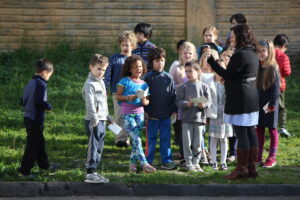
First grade teacher and children outdoors
A Waldorf first grade classroom is a magical place. The teacher stands before the students, ready to take them on an adventure. The students look up with adoration, ready and eager to follow. The shared warmth of the first joyful years together helps the class weather the sometimes bumpy nine-year-change. Every year the students return to a familiar social circle of classmates, surrounded by teachers who know and care for them. Their class teacher holds the students with thoughtful care and attention. The affection within the class helps them ride the wave of adolescent puberty together, through their differing spurts of growth and maturity. With their teacher’s support, they keep steady with the goal of respect and kindness for each other, as they pursue ever more expanding topics, teaching each other with their different perspectives in ever deepening discussions of life and knowledge in all their messy glory.
And suddenly, the students are in eighth grade. The class is solid together; the classmates support each other. When it counts, they are there for each other. And they are having fun. They are ready to go on together, to continue learning with each other. Now, their class teacher can step back and let them go on their next adventure – the complete wonder and even deeper thinking in high school, surrounded in support and warmth again, but this time with an extensive team of enthusiastic high school teachers who are ready to meet the world with them.
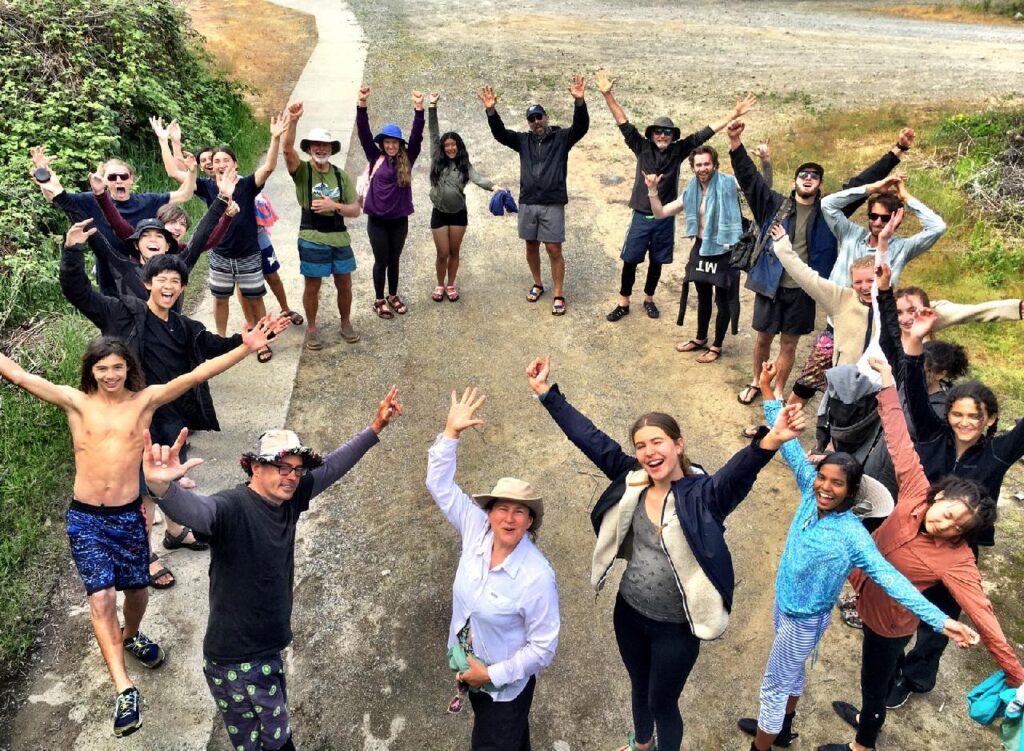
Photos of Mrs. Waheed and her class from first to eighth grades, from 2014 to earlier this month in 2023.
References
Rix, Kate. “The Benefits of Teacher Looping | K-12 Schools | U.S. News.” The Benefits of Teacher Looping, 24 Feb. 2023, www.usnews.com/education/k12/articles/the-benefits-of-teacher-looping.
Steiner, Rudolf. Discussions with Teachers: Fifteen Discussions with the Teachers of the Waldorf School in Stuttgart, August 21st to September 6th, 1919 ; Translated by Helen Fox. Rudolf Steiner Press, 1992.
Thompson, N. L., Franz, D. P., & Miller, N. (2009). Research summary: Looping. Retrieved 25 May 2023, from http://www.amle.org/TabId/198/ArtMID/696/ArticleID/311/Research-Summary-Looping.aspx.
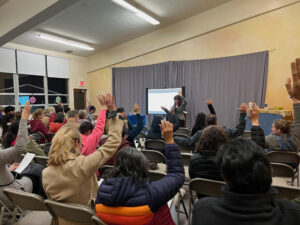
“It’s not where you go, it’s what you do there.” This is the advice of Dr. Denise Pope, Senior Lecturer at Stanford University and co-founder of Challenge Success, a non-profit affiliated with the Stanford University Graduate School of Education. She spoke to our community earlier this month for a workshop on “A Healthier Approach to College Admissions.” With humorous anecdotes and an engaging PowerPoint presentation, as well as her perspective as a parent who has gone through the admissions process with her own children, Dr. Pope emphasized that fit should be valued over rankings. Keeping a level head during the college search process is key for the well-being, engagement, and sense of belonging of all K-12 students.
 One of my favorite parts of the evening was when Dr. Pope handed out forms with a series of criteria for choosing a college or university to everyone in attendance. The form had 29 categories. For each category, we had to determine whether each was ‘‘not important”, “nice to have,” or “essential”. Here are just a few of them: 1. Diversity of the student body/faculty. 2. Community service opportunities. 3. Mental health services & supports. 4. Small class sizes. 5. Undergraduate academic reputation. It quickly became clear that no two people had the exact same marks or criteria. This brought home the ‘fit’ factor. What might be the right place for one student might not be the right place for another student. Dr. Pope also shared that popular college rankings, such as US News & World Report, used just ten factors to create their rankings, and by a show of hands it was noted that within our group very few present had prioritized any of those particular factors (Morse & Brooks, 2022).
One of my favorite parts of the evening was when Dr. Pope handed out forms with a series of criteria for choosing a college or university to everyone in attendance. The form had 29 categories. For each category, we had to determine whether each was ‘‘not important”, “nice to have,” or “essential”. Here are just a few of them: 1. Diversity of the student body/faculty. 2. Community service opportunities. 3. Mental health services & supports. 4. Small class sizes. 5. Undergraduate academic reputation. It quickly became clear that no two people had the exact same marks or criteria. This brought home the ‘fit’ factor. What might be the right place for one student might not be the right place for another student. Dr. Pope also shared that popular college rankings, such as US News & World Report, used just ten factors to create their rankings, and by a show of hands it was noted that within our group very few present had prioritized any of those particular factors (Morse & Brooks, 2022).
Dr. Pope also told attendees about her experiences when she was touring colleges and universities with her son. After a long car ride, they had arrived at one of the schools that her son had identified as a top match school. But when he saw the small size of the town, and had done a little research, he realized that the town only had three restaurants. Being a foodie, he could not fathom attending a school in an area with such limited cuisine options. He told his Mom, “I will not go to this school.” Taken aback, Dr. Pope reminded her son that there were several reasons this school had made it onto his college list in the first place. But she could tell her son’s mind was made up; the school was not for him. They quickly crossed it off his college list, got back into the car, and drove away because a good fit on paper may not always be one in person.
When I meet with one of our WSP students, my goal is for the two of us to identify schools where they can see themselves being happy; academically, socially, intellectually, mentally, and emotionally. We map out a plan for future success, not just in college, but in life. No stone is left unturned. We look at average classroom sizes, retention rates from freshman to sophomore year, but we also look at schools that have a cappella groups or choirs if a student has a love for singing. For another student on the Walbots, WSP’s robotics club, it could be making sure a college has a similar student group for them. College rankings are never discussed; personal fulfillment and happiness is our chief topic of discussion.
Dr. Pope reminded me that while the college search process is not an easy one, there are so many reasons to be hopeful that a student will make the decision that is right for them. As my high school seniors receive many of their admissions decisions over the next few days and weeks, I am excited for what lies ahead for them. Their best days are still to come!
Morse, R., & Brooks, E. (2022, September 11). How U.S. News calculated the Best Colleges Rankings – US News & World … US News & World Report. Retrieved March 31, 2023, from https://www.usnews.com/education/best-colleges/articles/how-us-news-calculated-the-rankings
A new study published in the JAMA Pediatrics suggests yet one more reason to manage tech at home. “Tempting as it may be to hand them a smartphone or turn on the TV as a default response, soothing with digital devices may lead to more problems with emotional reactivity down the road, a new study has shown,” writes Madeline Holcombein in a recent CNN article [link].
“‘Even slightly increasing a child’s emotional reactivity, that just means it’s more likely when one of those daily frustrations comes up, you’re more likely to get a bigger reaction,’ said lead study author Dr. Jenny Radesky, a developmental behavioral pediatrician.” Read the rest here.
Who hasn’t been there? Especially while trying to work and school at home during COVID. And if you haven’t, a long break from school filled with extended family and friend visits and extra tasks to complete might send you there.
Sometimes these habits can be hard to break. I recall when my, now 21-year-old, son was in kindergarten, a teacher telling us “A lot of televisions seem to ‘break’ during kindergarten.” Our TV didn’t actually “break,” but throwing a cloth over it did wonders. However, as we all know, it just isn’t the TV in the corner seeming to allure us for some temporary peace and quiet anymore; everywhere you turn there is a tempting device, especially if you turned to them during the last few years.
I always found rather than taking something away from my children, it was easier to instead give something new or different. Even waaay back when I was a child, my mother had a plastic tub of rice with cups, measuring spoons, and sieves in it; kept away only for rainy days. I may not have enjoyed that if it had always been available, but it certainly made the rare indoor rainy day very exciting!
So, after you read “Giving your child a screen may hinder emotional regulation, study says. Here’s what to do instead”, here are some more media-free ideas for people of all ages to indulge in over break, and beyond: